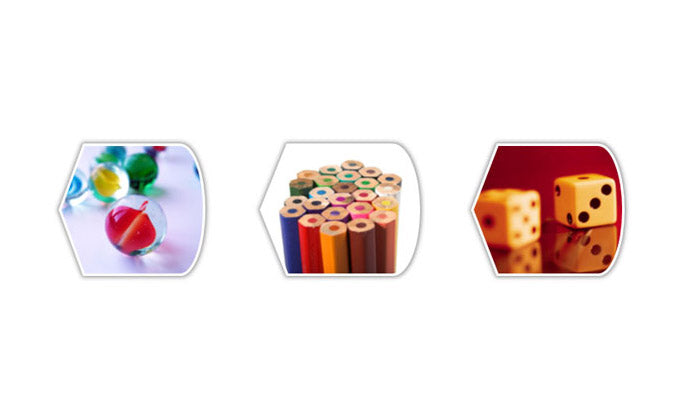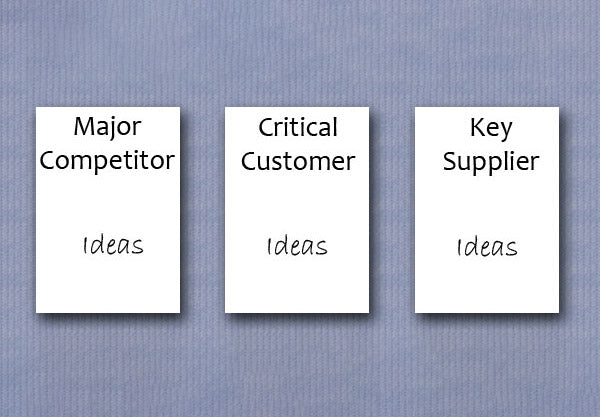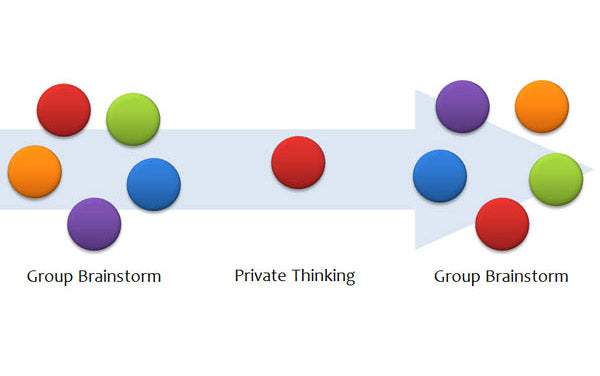In today’s competitive world, coming up with creative ideas sooner than your competitor can make all the difference between success and failure. However, creativity is not something that you can force people into or expect them to suddenly become creative by sheer will power.
Instead, creativity seems to be highly dependant on the state of your mind. It is about your brain. If you can provide a suitable environment for your brain, it can deliver many novel ideas rather quickly. On the other hand, a tired or stressed mind is almost useless for anything creative as if it can’t be set free.
Hence, to become creative you should simply focus on setting up your environment and adopt your behaviour in such a way to maximise your chances of success.
This article provides a series of guidelines you can use to become more creative.
Use systematic group-thinking methods
Freestyle brainstorming can lead to a variety of issues. Some people may not speak their mind out of fear. People are subject to group think, where everyone is eager for the group to agree. People also may self-censor themselves which reduces the likelihood of getting new ideas to the mix. For best results, use systematic creativity methods such as the Delphi Method, Six Hats, Mind Mapping, etc. Some of these methods encourage individual contribution and provide a system to merge individuals’ ideas together iteratively so everyone’s inputs are used.
Change your physical environment
If you are sitting behind your desk, move away from it. If you are in your office, leave and go for a walk. If you want to have a creative meeting with your colleague, don’t go into the usual meeting room. Leave the office and go for a walk while discussing the matter.
Monitor your physiology
Brain needs oxygen to operate at its best. Blood is the mechanism that brain receives its much needed oxygen and nutrients. If you are in an enclosed environment, make sure you have plenty of fresh air coming in especially if you have many people crammed into a small place. Larger rooms are more ideal as they simply contain more oxygen.
Praise individuals
Make sure everyone understands that their inputs are valuable and would never be ignored. Remember, this is not a one off approach; you need to convince people over a period of time that their views are trusted and valued.
Use random systematically
Shifting from one side of the search space to another sometimes requires a bold move. You may get there by bold thinking or being really dramatic, but sometimes a simple random idea dropped in can do all the wonders. Set up your environment in such a way to exploit random. For example randomly show a set of images in the corner of the meeting room (make sure it is not too distracting though), or use props.
Fill the room with props
Accidentally seeing something in the corner of your eye can trigger an unconscious response that may lead you to a new idea. Use props, magazines, paintings (especially those that are vague so you can imagine what you like), statues, unusual items and so on. Don’t use empty white rooms for creativity. They are only useful for meditation, relaxation and perhaps sleeping. Colours, diagrams, charts, etc. all help to get people inspired.
Don’t allow people to sit in meeting room
Research shows that movement greatly helps people to become more creative. It is as if stillness also freezes the mind. Remove the chairs from your target meeting room. This also encourages people not to get too comfortable and get on with the critical topic. It accelerates the meeting while at the same time makes it more creative.
Use large drawing space
As it is well known, communication with words is not our greatest strength. The medium is subject to all sorts of misunderstandings. Drawing can greatly help people to communicate ideas. Provide a large whiteboard, or a wall in the room dedicated for writing. Provide plenty of colour pens as well. Only use fancy technology such as touch displays if everyone is familiar with the technology, otherwise the novelty of the new gadget becomes a distraction rather than help.
Use incubation
Think hard, work hard, then do nothing. Yes, doing nothing is a great activity. While you get to attend to your errands, your mind works in the background. Sometime later, suddenly you know the answer and you may even come across it in the most unusual situations (such as how Archimedes came up with the idea of water displacement in a bath tub!). New research shows that the reason incubation works is because by letting go of the subject, we allow the brain to forget certain concepts or links. This allows the brain to get rid of some potentially limiting associations that keeps it focused on only one area of solutions. When the brain is freed, it can form new associations which eventually leads to the Eureka moment.
Comments
By Mohamad Turani @ Thursday, December 16, 2010 8:50 AM
Creative Methods
Here are the five classic ones:
1. Evolution. This is the method of incremental improvement. New ideas stem from other ideas, new solutions from previous ones, the new ones slightly improved over the old ones. For example, l...ook at the history of the automobile or any product of technological progress. With each new model, improvements are made. Each new model builds upon the collective creativity of previous models, so that over time, improvements in economy, comfort, and durability take place. Here the creativity lies in the refinement, the step-by-step improvement, rather than in something completely new.
2. Synthesis. With this method, two or more existing ideas are combined into a third, new idea. Combining the ideas of a magazine and an audio tape gives the idea of a magazine you can listen to, one useful for blind people or freeway commuters.
3. Revolution. Sometimes the best new idea is a completely different one, an marked change from the previous ones. While an evolutionary improvement philosophy might cause a professor to ask, "How can I make my lectures better and better?" a revolutionary idea might be, "Why not stop lecturing and have the students teach each other, working as teams or presenting reports?"
4. Reapplication. Look at something old in a new way. Go beyond labels; how something can be reapplied. One creative person might go to the junkyard and see art in an old model T transmission. He paints it up and puts it in his living room. Another creative person might see in the same transmission the necessary gears for a multi-speed hot walker for his horse. He hooks it to some poles and a motor and puts it in his corral.
For example, paint can be used as a kind of glue to prevent screws from loosening in machinery.
5. Changing Direction. Many creative breakthroughs occur when attention is shifted from one angle of a problem to another. This is sometimes called creative insight.
A classic example is that of the highway department trying to keep kids from skateboarding in a concrete-lined drainage ditch. The highway department put up a fence to keep the kids out; the kids went around it. The department then put up a longer fence; the kids cut a hole in it. The department then put up a stronger fence; it, too, was cut. The department then put a threatening sign on the fence; it was ignored. Finally, someone decided to change direction, and asked, "What really is the problem here? It's not that the kids keep getting through the barrier, but that they want to skateboard in the ditch. So how can we keep them from skateboarding in the ditch?" The solution was to remove their desire by pouring some concrete in the bottom of the ditch to remove the smooth curve. The sharp angle created by the concrete made skateboarding impossible and the activity stopped. No more skateboarding problems, no more fence problems.
This example reveals a critical truth in problem solving: the goal is to solve the problem, not to implement a particular solution. When one solution path is not working, shift to another. There is no commitment to a particular path, only to a particular goal. See more
By Ehsan Honary @ Monday, January 3, 2011 8:15 PM
Thanks Mohamad for your informative comment.
By B360 @ Thursday, August 16, 2012 2:01 AM
Thanks a lot! I really benifited from this! :)
Soft Skills Training Materials
Get downloadable training materials
Online Train the Trainer Course:
Core Skills
Learn How to Become the Best Trainer in Your Field
All Tags
Training Resources for You

Course Design Strategy
Available as paperback and ebook

Free Training Resources
Download a free comprehensive training package including training guidelines, soft skills training activities, assessment forms and useful training resources that you can use to enhance your courses.

Our Comprehensive Guide to Body Language

Train the Trainer Resources
Get Insights - Read Guides and Books - Attend Courses
Training Materials
Get downloadable training materials on: Management Training, Personal Development, Interpersonal Development, Human Resources, and Sales & Marketing














Leave a comment
All comments are moderated before being published.
This site is protected by hCaptcha and the hCaptcha Privacy Policy and Terms of Service apply.